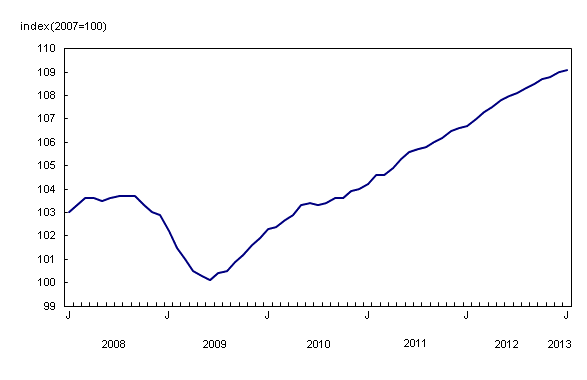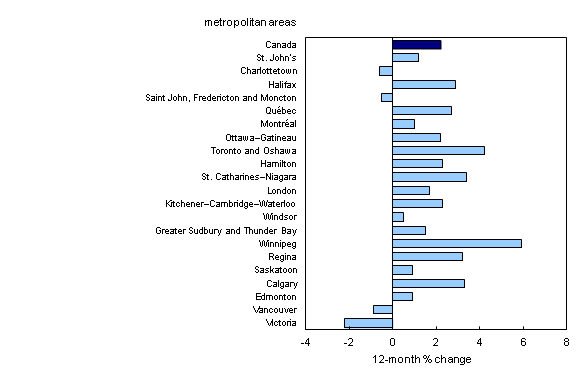New Housing Price Index, January 2013
Archived Content
Information identified as archived is provided for reference, research or recordkeeping purposes. It is not subject to the Government of Canada Web Standards and has not been altered or updated since it was archived. Please "contact us" to request a format other than those available.
Released: 2013-03-14
The New Housing Price Index (NHPI) rose 0.1% in January, following a 0.2% increase in December.
The combined metropolitan region of Toronto and Oshawa, as well as the region of Calgary, were the top contributors to the advance. Builders indicated that market conditions were the primary reason for higher prices in Toronto and Oshawa, while increased material and labour costs contributed to higher prices in Calgary.
The largest monthly price advance in January occurred in Charlottetown (+1.0%), where builders returned to list prices after having reported lower negotiated selling prices the previous month.
In Winnipeg, prices rose 0.9% month over month, the largest advance since September 2011. According to builders, the increases in Winnipeg were primarily a result of higher costs for developed land.
Monthly prices declined 0.2% in Ottawa–Gatineau, as a result of builders offering larger bonus packages to generate interest and stimulate sales. This was the first monthly decrease in the region since May 2011, when prices fell 0.7%.
New home prices decreased 0.1% in four metropolitan regions in January. Builders in the combined region of Saint John, Fredericton and Moncton, as well as Kitchener–Cambridge–Waterloo, Edmonton and Vancouver reported that they reduced prices in an attempt to generate sales.
Prices were unchanged in 7 of the 21 metropolitan regions surveyed.
On a year-over-year basis, the NHPI rose 2.2% in the 12 months to January, following a 2.3% increase the previous month.
The main contributor to the advance was the combined metropolitan region of Toronto and Oshawa, where the year-over-year increase in contractors' selling prices was 4.2%.
In Winnipeg, where the pace of the annual increases has been accelerating over the last several months, year-over-year prices were up 5.9% in January compared with a 4.0% advance over the same period in 2012.
Other significant year-over-year increases occurred in St. Catharines–Niagara (+3.4%), Calgary (+3.3%) and Regina (+3.2%).
Among the 21 metropolitan regions surveyed, 4 posted 12-month price declines in January. The largest annual decrease was in Victoria (-2.2%), followed by Vancouver (-0.9%). Victoria has posted year-over-year decreases for the past four years, while Vancouver has registered 12 consecutive months of annual declines.
Note to readers
The New Housing Price Index measures changes over time in the selling prices of new residential houses agreed upon between the contractor and the buyer at the time of the signing of the contract. It is designed to measure the changes in the selling prices of new houses where detailed specifications pertaining to each house remain the same between two consecutive periods. The prices collected from builders and included in the index are market selling prices less value added taxes, such as the Federal Goods and Services Tax (GST) or the Harmonized Sales Tax.
Effective January 1, 2013, the Quebec Sales Tax (QST) is calculated on the selling price not including GST. However, to ensure the total taxes payable remains the same, the QST rate has been increased to 9.975%.
The provincial government of British Columbia introduced legislation on May 14, 2012, announcing the return to a provincial sales tax on April 1, 2013. From April 1, 2012, until March 31, 2013, there are new housing transitional rebates in place. After the transition is complete, the provincial sales tax on building materials in British Columbia will be embedded in contractors' selling prices of new houses. These changes will be reflected in the New Housing Price Index as reported by respondents.
The indexes are not subject to revision and are not seasonally adjusted.
The fourth quarter 2012 issue of Capital Expenditure Price Statistics (Catalogue number62-007-X) will be available in April.
The New Housing Price Index for February will be released on April 11.
Contact information
For more information, or to enquire about the concepts, methods or data quality of this release, contact us (toll-free 1-800-263-1136; infostats@statcan.gc.ca) or Media Relations (613-951-4636; statcan.mediahotline-ligneinfomedias.statcan@canada.ca).
- Date modified:



